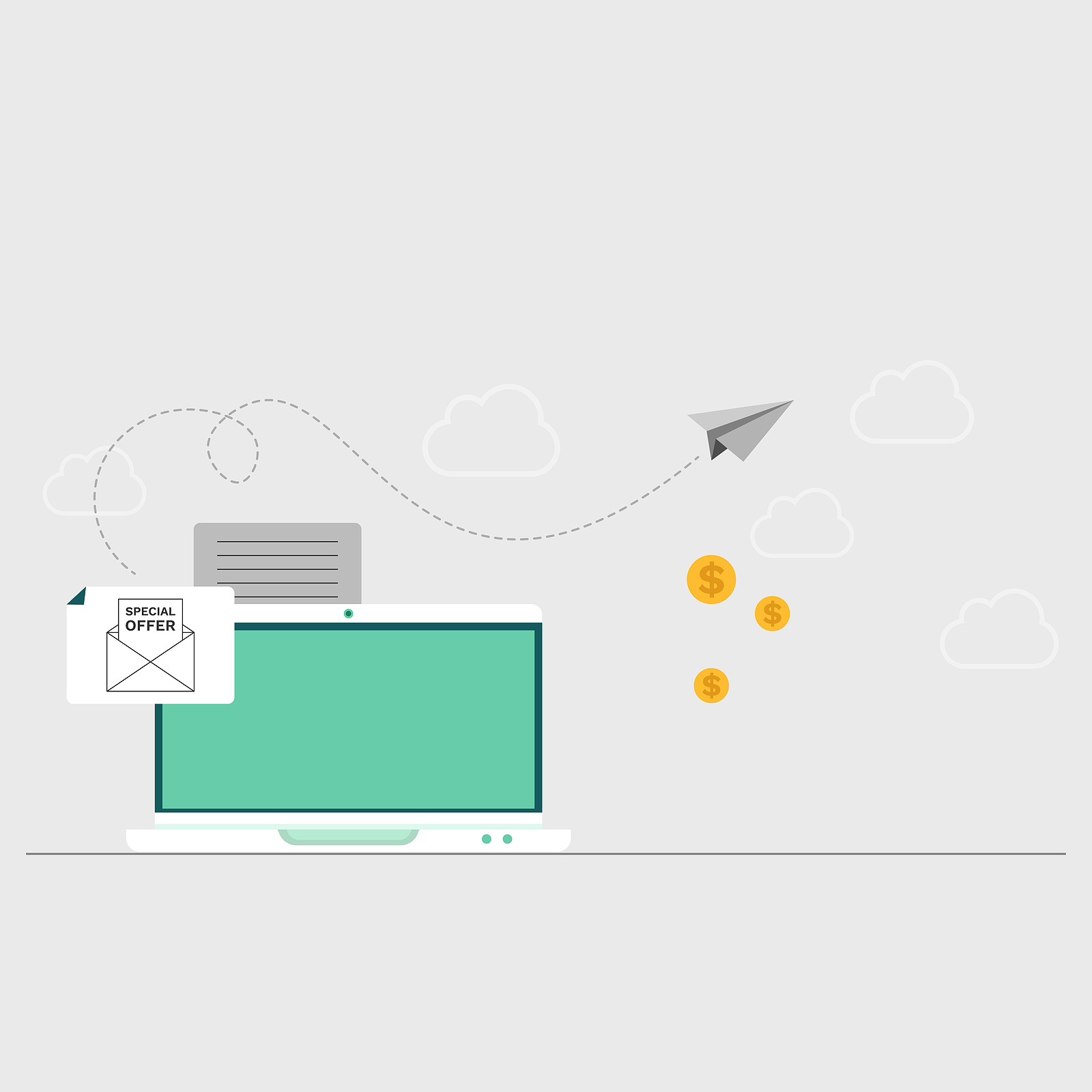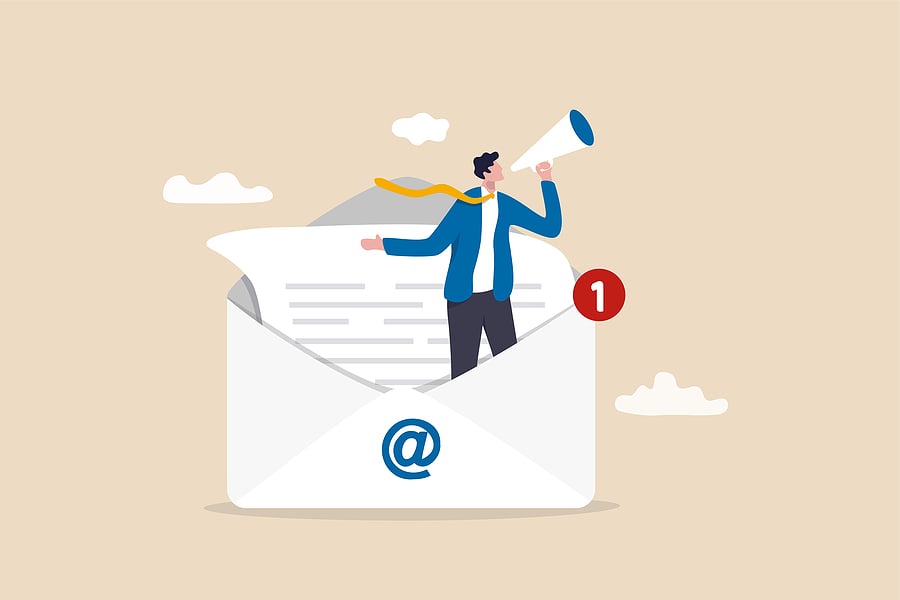2022 Email Marketing Trends That Will Truly Impact Your ROI
In 2019, more than 306 billion emails were sent and received every day. 😲 Yep, you read that right…EVERY DAY. And it’s expected that by 2025, that...
6 min read
 Mindy Traylor
:
August 16, 2024
Mindy Traylor
:
August 16, 2024

I recently sat down with Kari, our founder and Chief Creative Officer, to discuss email marketing. Many of our clients have questions about its effectiveness and what type of email marketing strategy to adopt to maximize their ROI.
Let’s take a look at what she had to say…
Absolutely. It’s still the best investment in terms of marketing dollars spent. In fact, your ROI averages out to $36 for every dollar you spend! It also helps you stay top of mind with prospects and current clients. Whether or not they open your email, they see your business name in their inbox.
For example, I was just in the Bighorn Mountains for a week and I wasn't really on social media during that time. If people were posting on social media, I probably missed their posts. However, when I got back from vacation, I had a lot of emails to go through. I saw every email that was sent to me while I was away and could go through them at my leisure.
So yes, email marketing is still very much alive and well. It’s a great tool to use for marketing and growing your business.
At a minimum, I would say you should be sending one email per month to your list.
That includes prospects, current clients, past clients, and referral partners. This will keep you top of mind. But beyond that, there are a couple of other things to consider.
Let’s say someone goes to your website and downloads a lead magnet. Maybe it’s a coupon for 20% off their next purchase or a checklist titled, The Top 10 Things You Need to Know About Email Marketing. There's a general rule of thumb that comes into play — if someone opts into your list, you can email them more in the first 7-10 days of that relationship.
Be sure to lead with value! Give them lots of helpful information up front so they continue to open your emails beyond that 7-10 day window.
There’s another rule of thumb that addresses email frequency and the sales cycle. For example, let’s say you’re a realtor. People typically only buy a house every 7-10 years or more, right? In this case, you don't want to send weekly emails because it would simply be too much.
On the flip side, if you own a restaurant and patrons can come in and dine twice a day, a shorter sales cycle with more frequent communication is fitting. I’d say you could safely share quality blog articles and other relevant content on a weekly basis.
Also, be mindful that if you're continually pushing out sales material (you know the companies that always have a special offer!), people are going to start tuning you out. They’ll get annoyed and be less likely to open your emails in the future.
So, in summary, I’d keep in mind what type of business you have and what your sales cycle looks like, your communication frequency, and what kind of content you’re sharing.

Definitely. If you have different lead magnets out there, like a coupon or a checklist, you want to make sure the contacts that come through are tagged according to that lead magnet. Then you can go back to them.
For example, if you just launched a new website for a client and wrote up a case study about it, you can go to your website list and send those prospects a targeted message about websites and direct them to your case study.
Other segments that I think are important include your current customers, your past customers, your prospects, and your referral partners. Those are four key lists that I would recommend for everyone. Make sure to tag them in your system. For clients who’ve left, you can send a periodic message, “Hey, we've got a new offering,” or “We've missed you! We'd love to have you back.” Stuff like that. I think those are the top four.
Then, if you can segment them by industry, category type, lead magnet, etc., that will help you tailor your messaging to what your prospects are interested in and what they're thinking about.
We get that question a lot! For sales emails, I like to follow the 80/20 rule, which we talk about across all different marketing aspects and channels. 80% should be educational, and 20% should be promotional.
Typically, when we're creating an email for a client, there's probably going to be two or three sections within that email, and we're going to have one main call to action.
For example, we could include a blog article that we wrote for the client, something fun or something that they would find interesting, and a call to action. Because of how emails are set up, I think you can include a mix of both fun/educational content and a sales pitch.
But as we said before, you don't want to get to the point where you're always sending out sales-related emails or promotional emails because people will tune them out.
Learn more about the marketing 80/20 rule (and enjoy a funny video from one of our team members) in our recent blog!

Tuesdays and Thursdays between 9 and 3 tend to be the best days and times.
I don't think the content is as much of a factor as who you're sending your email to. Interestingly enough, those stats change yearly, if not every six months. It’s always a good idea to Google, “What is the best day/time to send an email in the ______ industry?”
One of our clients is a business broker. When we looked at what the best day/time is to send emails about businesses that are going up for sale or that hit the market, we learned that Sundays at 5 PM is the perfect time.
This seemed unusual at first, but if you think about it, a business owner is probably sitting down in front of their computer getting set up for the week ahead. We tried sending emails on Sundays at 5 PM and found it worked really well!
That’s a loaded question! One thing I can tell you right out of the chute is that using the same boring subject line every time will have the opposite effect you want — prospects will start to tune you out.
At Wild Fig, if we’re solving a problem in our email that our customer is currently facing (or we’re directing them to the solution in our email), we’ll lead with the problem in the subject line: “Are you tired of XYZ?”
Get creative with the subject line, but don’t get too abstract. If your subject line is, “Do monkeys eat bananas?” that’s probably not going to compel your readers to open your email.
Consider doing a split test. Come up with two different subject lines and see which one leads to more opens.
My No. 1 tip is to have a pop-up lead magnet on your website.
I know some people cringe at the word “pop-up.” But they’re very effective. If I’m on a website that I haven't been on before, and I can spin the wheel and see what kind of discount I get, I'm inclined to do it. It doesn't hurt me, right? You've done the work to get the traffic there. Now, capture their information so that you can continue to build on that relationship.
That same lead magnet can also be utilized on your social media channels. Extend your offer on Facebook or LinkedIn. For example, “Click here to download our guide, 25 Days to Better Email Marketing ROI,” will appeal to your website and social media visitors alike.
One more tip, and it’s going to sound very basic. If you’re having conversations with a prospect, be sure to add them to your email list!

At Wild Fig, we like to highlight who we are as individuals. People do business with people, not businesses, so pull the curtain back and showcase your team members — things you're interested in, hobbies, etc. This will help you form connections with people and show them what it's like to work with your team.
Along those lines, be authentic. During COVID, there was a lot of fear and uncertainty. Our team started to collect and share the best COVID memes we came across each week. We knew that our clients were struggling — everyone was struggling — so we wanted to bring a little light into the world. We got a boatload of responses from people saying, “Hey, thanks for making me smile. I needed that today.”
Our goal wasn’t to generate leads. Our aim was authenticity and continuing to nurture relationships. Today, those same people still open our emails because they know there's probably something fun in there or something that's going to make them laugh, in addition to valuable content.
If you don’t have an email marketing strategy, or you're not getting great results with your current email marketing strategy, here are two tips:
#1: Look at your emails through the eyes of your current customers or prospects. Ask yourself: Is this content resonating? Is this information that I'd want if I were in this particular industry or if I was this person?
#2: Plan your content. Take the time to plan out your content, even up to three months at a time. Think about challenges your clients might be facing during certain seasons of the year, around the holidays, etc. and address those.
Taking a thoughtful approach to your email marketing will help you increase your return on investment.
Thank you for joining us today, Kari! We appreciate you sharing your valuable email marketing insights with us.
Looking for more help with your email marketing? At Wild Fig, we love creating fun, educational, and effective email marketing for our clients. Schedule an exploratory call with Kari to discuss your needs and learn how we can help!

In 2019, more than 306 billion emails were sent and received every day. 😲 Yep, you read that right…EVERY DAY. And it’s expected that by 2025, that...

2 min read
Originally published June 2017; Updated May 2024. Did you know that, every day throughout the world, over 306 billion emails are sent and...

In 2022, the number of global email users was forecast at 4.3 billion. In 2025, that number is expected to grow to 4.6 billion—that’s more than half...